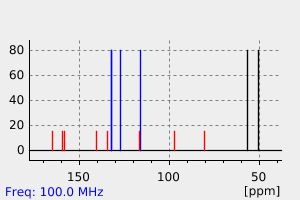Methyl 2-amino-3-cyano-4-methoxyazulene-1-carboxylate | 171363-10-3
中文名称
——
中文别名
——
英文名称
Methyl 2-amino-3-cyano-4-methoxyazulene-1-carboxylate
英文别名
——
CAS
171363-10-3
化学式
C14H12N2O3
mdl
——
分子量
256.261
InChiKey
ALFKURGUPVPDHH-UHFFFAOYSA-N
BEILSTEIN
——
EINECS
——
-
物化性质
-
计算性质
-
ADMET
-
安全信息
-
SDS
-
制备方法与用途
-
上下游信息
-
文献信息
-
表征谱图
-
同类化合物
-
相关功能分类
-
相关结构分类
计算性质
-
辛醇/水分配系数(LogP):2.3
-
重原子数:19
-
可旋转键数:3
-
环数:2.0
-
sp3杂化的碳原子比例:0.14
-
拓扑面积:85.3
-
氢给体数:1
-
氢受体数:5
上下游信息
-
下游产品
中文名称 英文名称 CAS号 化学式 分子量 —— 3-Cyano-2-diazo-4-oxo-2,4-dihydro-azulene-1-carboxylic acid methyl ester 171363-18-1 C13H7N3O3 253.217
反应信息
-
作为反应物:描述:Methyl 2-amino-3-cyano-4-methoxyazulene-1-carboxylate 在 硫酸 、 sodium nitrite 作用下, 以 1,4-二氧六环 为溶剂, 反应 2.0h, 以99%的产率得到3-Cyano-2-diazo-4-oxo-2,4-dihydro-azulene-1-carboxylic acid methyl ester参考文献:名称:New Method for the Synthesis of Polyether-Bridged Azulenes: Reactions of Conjugated Ketocarbenes Generated from the Corresponding Azulenoquinone Diazides摘要:The diazide of 2,4-azulenoquinone carrying 1,3-cyano and carbomethoxy substituents was synthesized and photolyzed in cyclic ethers (THF, dioxane, and tetrahydropyran) to give good yields of 2,4-polyether-bridged azulenes. The shapes of some azulene polyethers were examined by X-ray structural determination to show the cavity size ranging from 6.4 to 4.1 Angstrom (long-short diameters) to 7.36-6.6 Angstrom encircled by an azulene and polyether are. In analogy to 2,5-cyclohexadien-4-onylidenes, photogenerated conjugated azulenone carbenes were assumed to have energetically closely spaced triplet and singlet ground states that can interconvert readily and react from one of these states under ambient conditions. The spanning of a polyether bridge is initiated by the electrophilic attack of a singlet state on the oxygen of solvent ethers, followed by one or two propagation steps and a ring closure by phenolate attack. The 1,3-dicarbomethoxy group could exert steric effects to hinder the approach of the ether oxygen and control the polyether spanning processes and ring size; this caused a triplet state reaction to supersede the overall reaction. While radical and insertion reactions are common for ketocarbene reactions, the present description adduces a well manifested electrophilic reaction of the allied transients.DOI:10.1021/jo971494u
-
作为产物:描述:3-(甲氧羰基)-2H-环庚[b]呋喃-2-酮 在 盐酸 、 sodium hydroxide 、 sodium methylate 、 silver nitrate 作用下, 以 甲醇 为溶剂, 反应 10.0h, 生成 Methyl 2-amino-3-cyano-4-methoxyazulene-1-carboxylate参考文献:名称:Formation and structure of 2-diazo-2,4-azulenequinone derivatives摘要:The diazotization of methyl (and ethyl) 2-amino-3-cyano-4-methoxy(and ethoxy)azulene-1-carboxylate (1-4) was examined to determine whether the products are 2-diazo-2,4-azulenequinone derivatives (B) or azulene-2-diazonium-1-carboxylate derivatives (C). Since diazotization of 1 and 2 gave the same diazo compound 5 and diazotization of both 3 and 4-gave diazo compound 6, the diazo compounds are deduced to not be azulene-2-diazonium-1-carboxylate derivatives (7 and 8), but rather to be 2-diazo-2,4-azulenequinone derivatives (5 and 6). The diazo carbons of both 5 and 6 show C-13 NMR signals at delta 66.3, and their carbonyl carbons resonate at 6 181.1, in good agreement with a 2-diazo-2,4-azulenequinone structure. The structures of diazo compounds 24 and 25, which we have previously reported,(1) are reexamined on the basis of the analysis of their C-13 NMR spectra. The contribution of a quinoid structure and a diazoazulenolate structure to 5, 6, 24, and 25 is discussed by comparison of their C-13 NMR spectral data with those of 4-diazo-2,5-cyclohexadien-1-one derivatives. It is concluded that the contribution of the quinoid structure is larger than that of the diazoazulenolate structure.DOI:10.1021/jo00123a031
表征谱图
-
氢谱1HNMR
-
质谱MS
-
碳谱13CNMR
-
红外IR
-
拉曼Raman
-
峰位数据
-
峰位匹配
-
表征信息
同类化合物
高密聚乙烯
香叶醇
顺式3-甲基-2-己烯
顺式-5-癸烯
顺式-5-甲基-2-己烯
顺式-5-庚烯-1-炔
顺式-4-癸烷
顺式-4-甲基-2-戊烯
顺式-4-甲基-2-戊烯
顺式-3-癸烯
顺式-3-甲基-3-己烯
顺式-3-甲基-2-庚烯
顺式-3-戊烯-1-炔
顺式-3,4-二甲基-3-己烯
顺式-3,4-二甲基-2-戊烯
顺式-3,4-二甲基-2-戊烯
顺式-2-甲基-3-己烯
顺式-2-壬烯
顺式-2-丁烯-D1
顺式-1.1.1-三甲基-2-丁烯
顺式-1-甲基-2-环丙基乙烯
顺式-1-甲基-2-乙烯基环戊烷
顺式-1-环戊基-1-辛烯
顺式-1-氘代-3-甲基-1-丁烯
顺式-(9ci)-2,3,3a,7a-四氢-4-(1-甲基乙基)-1H-茚
顺式-(2-丁烯基)环丙烷
顺式,顺式-2,4-己二烯
顺-环辛烯
顺-9-二十一碳烯
顺-6-十三碳烯
顺-5-甲基-1,3,6-庚三烯
顺-4-辛烯
顺-4-壬烯
顺-3-辛烯
顺-3-甲基-2-戊烯
顺-3-壬烯
顺-3-十三碳烯
顺-2-辛烯
顺-2-癸烯
顺-2-戊烯
顺-2-庚烯
顺-2-己烯
顺-2-丁烯
顺-2,2-二甲基-3-己烯
顺-1,3-戊二烯
顺,顺-1,9-环十六烷二烯
顺,顺,顺-环癸-1,3,5-三烯
间戊二烯
间二(4-吡啶基)苯
镁,二-2-丁烯基-







